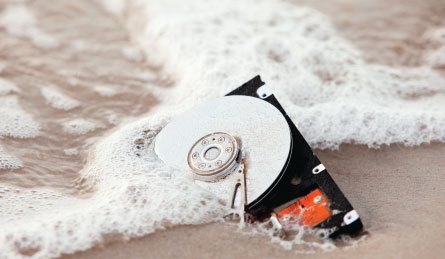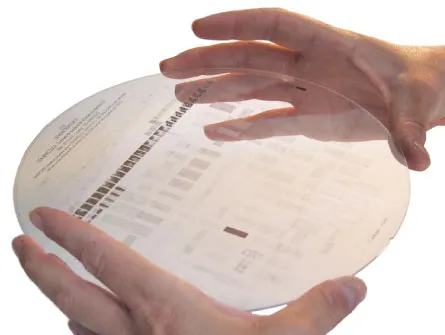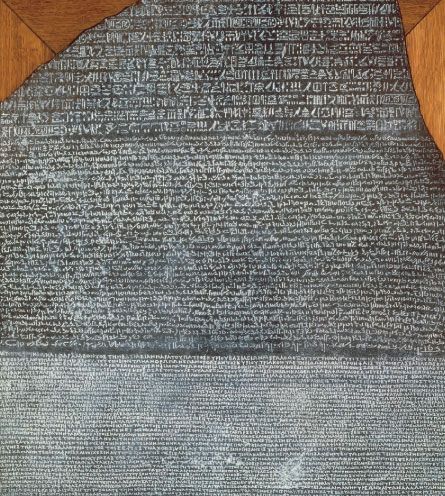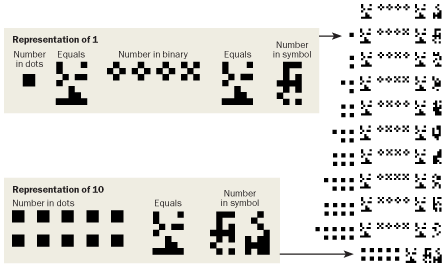Dear Future Earthlings
A message in a bottle won’t be enough to communicate with distant generations
When Geoffrey Chaucer wrote The Canterbury Tales, he probably didn’t think much about the students who would painstakingly slog through the text hundreds of years later. This literary classic is loaded with references and expressions specific to its author’s time — part of what makes it so difficult to read, even with CliffsNotes to serve as a decoder ring.




Likewise, people of the future will no doubt face tremendous challenges interpreting the texts of today. Far enough forward in time, it won’t just be an issue of literary style. To be understandable tens of thousands of years from now, ideas must be expressed in a language that lasts and stored in a form that can survive millennia.
Storytellers may be willing to take their chances. But for others, leaving notes for the future is a task of great concern. Whether passing along a basic understanding of biology, documenting historical events or clueing future generations in to potential hazards, scholars believe some messages are imperative to convey. These forward thinkers have long been interested in designing messages that can be read and understood by people as unknowable to present-day generations as present-day generations would have been to Chaucer, or even the Neandertals.
New hardware for long-term message storage was reported earlier this year in Dublin at the Euroscience Open Forum, where archaeologists and nuclear scientists gathered to discuss how to warn future generations about buried nuclear waste. As for making the messages understandable, recent efforts by linguists and cultural anthropologists studying ancient Egypt’s Rosetta Stone may suggest a trick. Anyone looking to communicate with the future could also take clues from astronomers attempting to get the attention of extraterrestrials; these efforts emphasize the importance of context.
Though some experts believe communicating with future humans may well be impossible, linguist Robert Millar of the University of Aberdeen in Scotland is optimistic. “They won’t understand everything about the message,” he says, “but they may be able to get pretty close.”
Long-term storage
Books like those used in English class aren’t suitable for holding messages destined for deep time, says Patrick Charton, a mechanical engineer at Andra, the French nuclear waste management agency, headquartered outside Paris. Although some manuscripts from the Middle Ages survive today, paper typically lasts only a few centuries, even when stored under the right environmental conditions. Clay tablets like those excavated from archaeological digs throughout the Middle East are more durable, but they too have to be preserved properly. Prolonged exposure to moisture can turn these archives into mud.
Today’s digital media devices may store vast amounts of data — somewhere around half a million books or about 2,000 hours of CD-quality audio can fit on a one-terabyte hard drive — but the lifetime of these devices is shorter than that of paper and clay tablets. Even if the equipment needed to read the hard drives sticks around, the devices themselves deteriorate within a few decades, if not sooner.
French researchers have come up with one solution: Engineers led by Alain Rey of Arnano, a company based in Grenoble, start with a thin, 20-centimeter-diameter disk of a form of aluminum oxide known as industrial sapphire. These transparent disks, which look like large CDs, are acid-resistant, scratch-resistant and more than five times as strong as tempered glass, Rey says.
The researchers engrave text or images into the surface of a disk and fill the etchings with platinum, which is more resistant to corrosion than gold. Finally, the team protects the information by fusing a second disk to the one containing the information. Charton, who oversees the French nuclear agency’s program to develop long-lasting nuclear waste warnings, described the sapphire-and-platinum data sandwich in July at the Euroscience Open Forum.
Each disk can be etched with tiny images of tens of thousands of pages of information, Charton said, and acid tests suggest the disks could last as long as 1 million years. Another plus: People who discover the disks won’t need an electronic device to read them, only a simple microscope.
Creating a data-storage method that could last as long as it takes for nuclear waste to become relatively harmless (SN: 2/27/88, p. 139) is only one hurdle in leaving warnings for far-distant generations. Scientists must also consider the language used to convey the message.
Death and evolution
When it comes to choosing which language to use to communicate with the future, there is good news and bad. The good news is that there are a multitude to choose from: Today, people on Earth speak somewhere between 6,000 and 7,000 languages. The bad news: By some estimates, one of those languages disappears every two weeks or so.
Rather than choose to encode a message in just one language, researchers might take a cue from the Rosetta Stone and choose several. The 760-kilogram chunk of black granite, discovered in Egypt in 1799, was inscribed with a decree issued by King Ptolemy V more than 2,200 years ago. Of great help to archaeologists, the message had been chiseled in three different scripts: Greek, Demotic Egyptian (a language used in Ptolemy’s day for everyday communications and records) and hieroglyphs (most often seen on temples and used for sacred texts).
Demotic Egyptian disappeared as a language in the 5th century A.D., and hieroglyphs were similarly unintelligible, says Janet Johnson, an Egyptologist at the University of Chicago. But because Greek was a well-known language and the differences in the three texts were minor, the researchers could decipher the Demotic Egyptian language and the hieroglyphs. The messages written in those languages on the Rosetta Stone, in turn, have helped decode ancient documents throughout Egypt.
“The Rosetta Stone was the key,” Johnson says. In August, she and her colleagues unveiled a dictionary of Demotic Egyptian, the culmination of a 37-year effort to give new life to a forgotten language.
Even when a language is rediscovered, though, much of a message can be lost to context, Millar says. “When a language is lost, there’s also a loss of culture, a loss of the stories that were told in that language.”
John Traphagan, a cultural anthropologist at the University of Texas at Austin, agrees, noting that a great depth of knowledge is needed to interpret even simple messages. “Even among humans today, languages and cultures can be different enough that communication is nearly impossible,” he says. “And the pace of change today is so rapid, 500 years from now it will be a different world altogether.”
Humans sending messages into space, to connect with whoever — or whatever — is out there, have realized that context is everything. Anyone composing messages to future generations may have something to learn from attempts to communicate with alien civilizations.
Lessons from E.T.
In the early 1970s, NASA’s Pioneer 10 and Pioneer 11 missions were launched to the outer solar system. They swooped past Jupiter and got a gravitational boost toward interstellar space. Each craft carried a gold-coated plaque with a sketch of the probe and a crude map of the solar system and where it lies in relation to certain fast-rotating stars known as pulsars. The plaques also had several symbols meant to provide information about the origin of the craft.
One symbol easily understood by humans but possibly meaningless to aliens who might intercept the messages is the arrow depicting the route of the craft out of the solar system, says Traphagan. While a society with a hunter-gatherer heritage would know that the tip of an arrow points forward, aliens without that shared past might see a random symbol. “There’s nothing specific about that that denotes direction,” Traphagan says.
Another space-bound signal, dubbed the Arecibo message after the radio telescope that broadcast it in November 1974, consisted of 1,679 ones and zeros. If aliens arrange these data in a picture that consists of 23 columns and 73 rows — a purportedly obvious choice given that 1,679 is the product of these two primes — the message depicts the numbers one through 10, the chemical formulas for the major components of DNA, a stick figure sketch of a human and various other scientific data.
When other researchers saw the Arecibo message, designed by astronomer Frank Drake, many were befuddled. “They didn’t automatically ‘get it,’ ” Traphagan says. The portions providing information about DNA were particularly confusing.
Nevertheless, scientists say, the Arecibo message is a step in the right direction. “You can’t just start with a complex message,” says Yvan Dutil, an astrophysicist now at the University of Quebec in Montreal. “You have to do a lot of teaching before you can talk.”
Dutil and colleague Stéphane Dumas have designed a longer and more sophisticated radio message for alien civilizations, dubbed the Interstellar Rosetta Stone.The message, described in the recent book Communication with Extraterrestrial Intelligence, starts out by introducing numbers, equations and other mathematical symbols and concepts. Then it builds the foundation for understanding physics, chemistry and biology. Finally, it delves into language, providing a vocabulary, a dictionary and grammatical rules.
Using these foundations, researchers can construct a meaningful message, Dutil says. “The first part of the message will be very boring,” he says. But the boring parts will form the foundation, allowing for true communication.
Besides having many layers of information, Dutil says, messages sent into deep space — as well as those intended for generations deep in the future — should be incredibly redundant. Repeating information often ensures that the message can be reconstructed even if part of it becomes destroyed or garbled. Moreover, the message should be presented in many different ways: Text, images, symbols and even music and art are just a few possibilities.
“If you convey a message in multiple ways, the chances of it being interpreted correctly goes up,” says Traphagan. “You have to try a lot of different things, because you don’t know what’s going to work.”
Though there aren’t yet clear conclusions on how to leave long-lasting messages, gatherings such as the one at the Euroscience Open Forum bring people together to generate new considerations and possible solutions. Because no one can ever know what will work reliably, all that can be offered is a best attempt.
“In the coming millennia, cultures and languages will change in ways that we can’t foresee,” archaeologist Anders Högberg of Linnaeus University in Kalmar, Sweden, said at the meeting. “We will not be understood in the future the way we’d like to be understood.”
But Egyptologist Johnson takes a more sunny view. “As long as you have some records, and as long as you have some interested human beings,” she says, “there is always the hope of reconstructing a message.”
Safe storage
Designing a device to hold messages for deep time means thinking ahead and recognizing possible data destroyers. Long-lasting devices should be:
– Made of nonradioactive, stable materials
– Resistant to fire
– Resistant to corrosion
– Insensitive to light
– Impossible to counterfeit
– Capable of being updated
– Indifferent to technological evolution
– Compact
– Maintenance-free